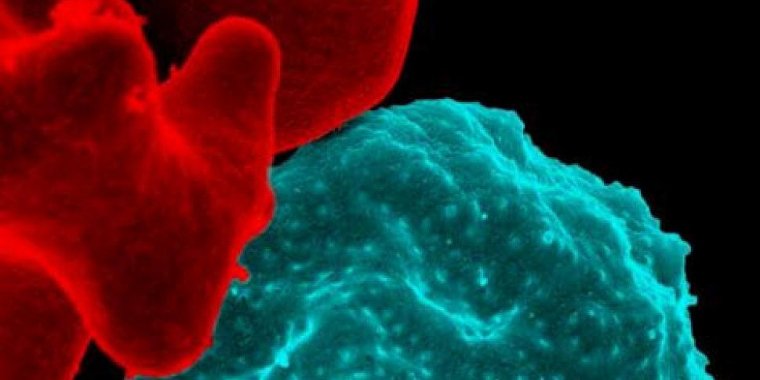| News / Science News |
Researchers discover new set of channels connecting malaria parasite and blood cells
Researchers at the National Institutes of Health and other institutions have discovered another set of pore-like holes, or channels, traversing the membrane-bound sac that encloses the deadliest malaria parasite as it infects red blood cells.

Colorized scanning electron micrograph of red blood cell infected with malaria parasites, which are colorized in blue. The infected cell is in the center of the image area. To the left are uninfected cells with a smooth red surface. Photo: NIAID
The channels enable the transport of lipids — fat-like molecules — between the blood cell and parasite, Plasmodium falciparum. The parasite draws lipids from the cell to sustain its growth and may also secrete other types of lipids to hijack cell functions to meet its needs.
The finding follows an earlier discovery of another set of channels through the membrane enabling the two-way flow of proteins and non-fatty nutrients between the parasite and red blood cells. Together, the discoveries raise the possibility of treatments that block the flow of nutrients to starve the parasite.
In 2018, there were 228 million cases of malaria worldwide, leading to more than 400,000 deaths, 67% of which were among children under 5, according to the World Health Organization.
In the current study, researchers determined that the channels through the sac, or vacuole, that encloses the parasite are made of Niemann-Pick C1-related protein (PfNCR1).
The PfNCR1 channels are restricted to locations where the vacuole membrane touches the parasite’s membrane. The channels the team discovered in the previous study are formed by exported protein 2 (EXP2).
Areas of the vacuole membrane containing EXP2 are located far from the parasite’s membrane, at an average distance of 20 to 40 nanometers.
The researchers believe that the parasite may use this variation in distance to separate the two transport systems. (National Institutes of Health)
YOU MAY ALSO LIKE





